-

初中化学人教版九年级上册《实验活动3燃烧的条件》教案
【学习目标】1.知识与技能:加深对燃烧条件的认识,进一步了解灭火的原理。2.过程与方法:体验实验探究的过程,学习利用实验探究的方法研究化学。3.情感态度与价值观:利用化学知识解释实际生活中的具体问题,使学生充分体会到化学来源于生活,服务于社会。【学习重点】通过物质燃烧条件的探究,学习利用控制变量的思想设计探究实验,说明探究实验的一般过程和方法。【学习难点】利用控制变量的思想设计对照实验进行物质燃烧条件的探究。【课前准备】《精英新课堂》:预习学生用书的“早预习先起步”。《名师测控》:预习赠送的《提分宝典》。情景导入 生成问题1.复习:什么叫燃烧?燃烧条件有哪些?今天自己设计实验来进行探究。2.明确实验目标,导入新课。合作探究 生成能力学生阅读课本P150的相关内容并掌握以下内容。实验用品:镊子、烧杯、坩埚钳、三脚架、薄铜片、酒精、棉花、乒乓球、滤纸、蜡烛。你还需要的实验用品:酒精灯、水。1.实验:用棉花分别蘸酒精和水,放到酒精灯火焰上加热片刻。上述实验中我们能观察到什么现象?说明燃烧需要什么条件?如果在酒精灯上加热时间较长,会发生什么现象?答:蘸酒精的棉花燃烧,蘸水的棉花没有燃烧,说明燃烧需要有可燃物。如果加热时间较长,水蒸发后,蘸水的棉花也会燃烧。2.如图所示,进行实验:我们能观察到什么现象?说明燃烧需要什么条件?答:在酒精灯火焰上加热乒乓球碎片和滤纸碎片,都能燃烧,说明二者都是可燃物。放在铜片两侧给它们加热后可看到乒乓球碎片先燃烧,说明燃烧需要温度达到可燃物的着火点。3.你能利用蜡烛和烧杯(或选择其他用品)设计一个简单实验证明燃烧需要氧气(或空气)吗?答:点燃两支相同的蜡烛,然后在一支蜡烛上扣住一只杯子,看到被杯子扣住的蜡烛一会儿就熄灭,说明燃烧的条件之一是需要氧气。
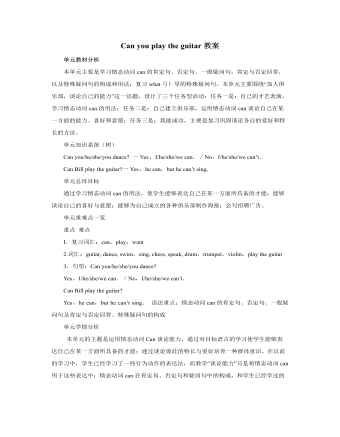
人教版新目标初中英语七年级上册Can you play the guitar教案
本单元主要是学习情态动词can的肯定句、否定句、一般疑问句,肯定与否定回答,以及特殊疑问句的构成和用法;复习what弓!导的特殊疑问句。本单元主要围绕“加人俱乐部,谈论自己的能力”这一话题,设计了三个任务型活动:任务一是:自己的才艺表演,学习情态动词can的用法;任务二是:自己建立俱乐部,运用情态动词can谈论自己在某一方面的能力、喜好和意愿;任务三是:我能成功,主要是复习巩固谈论各自的爱好和特长的方法。单元知识系统(树)Can you/he/she/you dance? 一Yes,I/he/she/we can./No,I/he/she/we can’t.Can Bill play the guitar?一Yes,he can,but he can’t sing.单元总体目标通过学习情态动词can的用法,使学生能够表达自己在某一方面所具备的才能;能够谈论自己的喜好与意愿;能够为自己成立的各种俱乐部制作海报;会写招聘广告。单元重难点一览重点 难点I.复习词汇:can,play,want2.词汇:guitar, dance, swim,sing, chess, speak, drum,trumpet,violin,play the guitar3.句型:Can you/he/she/you dance?Yes,I/he/she/we can./No,I/he/she/we can’t.Can Bill play the guitar?

人教版新目标初中英语七年级上册Do you have a soccer ball教案
在这一单元中,学生要学会就有关人与物之间所属关系进行问答的句子。本单元大量引入有关运动的名词,要求学生彼此询问有无此类物品,并做出相应的回答。 同时学习表示建议的句型Let’s运动的形容词。 本单元所选用的话题来自学生所喜欢的生活片段,在教学中生生交流、师生交流会更融洽,会促进师生彼此间的了解,成功的教学还会让部分学生养成良好的运动习惯和收藏习惯。 教学目标 1) 语言知识:A.在询问对方是否有某物的对话中学会使用do和does引导的一般疑问句; B. 学会使用描述性的形容词来评价事物; C. 学会在对话中使用名词复数; D. 学会用祈使句来向对方提出建议. 2) 语言技能:A. 学会用祈使句询问某人是否有某物; B. 学会向他人提出建议的句子. 3) 学习策略:A.通过与同学讨论,做出猜测;

人教版新目标初中英语七年级上册How much are these pants教案
个性练习设计 阅读广告:在日常生活中,人们去买东西之前,一般要阅读广告,从广告中获取该商品的一些有用信息,包括价格、性能等。所以给学生提供有些商品的广告或让学生去商店去阅读一些商品的广告,从中获取商品的价格,即可以锻炼学生的阅读能力,又能提高实践能力。 Self Check 教学内容 Self Check(教材P42) 教学目标 知识与能力 复习词汇pant,sock,T-shirt,sweater,shoes,color,black,white,red,green,blue,big,short,long,数字10--31; 学习词汇Zig Zag,clothes,shop,yellow,ask,which;学会谈论服装的价格、颜色、大小和长短;学会填写价格标签。 过程与方法 运用Summarizing和Classifying的学习策略。在复习教学中,运用听写、绘画、互相询问调查与检测等手段,促使学生不断地使用所学内容,从而提高他们灵活运用知识的能力。 情感态度价值观 该部分学习内容主要是复习谈论服装的价格和颜色以及对服装的喜好,能引起学生的共鸣;通过购物的对话练习教学生学会购物时使用的礼貌用语和如何感谢人。

人教版新目标初中英语八年级上册How do you make a banana milk shake教案2篇
1. First, ... then, ... next, ... finally, ...首先,……然后,……接着,……最后,……这是英语中表达做某事的步骤的一种说法。如果步骤较多,还可以说:first-next-after that-later on-finally/at last通常你会听到说英语国家的人在说 first, next, then, finally 和后面的内容时,他们会做一些停顿。这样就能提前告诉听者接下来讲的是一系列的步骤。这一点在朗读和听力中应特别注意。2. how many, how much均为疑问词,同是“多少”,但用法不同。请看:how many修饰可数名词复数,how much修饰不可数名词。但在用法上,同学们常犯如下错误:1) [误] How many are there bananas on the table?[正] How many bananas are there on the table?[析] how many, how much 中的many,much是形容词,常修饰名词作定语,故后面跟名词。2) [误]How much tea are there on the table?[正]How much tea is there on the table?[析] how much修饰不可数名词时,谓语动词用单数。how many与how much的区别可简记为:前how many:问“多少”,复数名词后面跑;how much问“多少”,不可数名词单数好。前者答语用基数词,后者答语用数量关系。
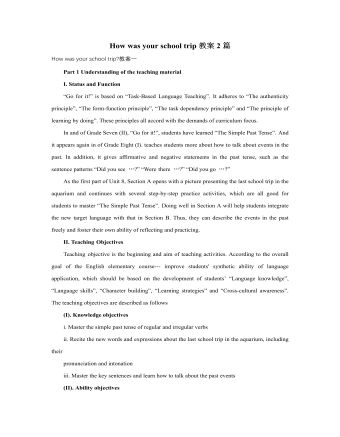
人教版新目标初中英语八年级上册How was your school trip教案2篇
“Go for it!” is based on “Task-Based Language Teaching”. It adheres to “The authenticity principle”, “The form-function principle”, “The task dependency principle” and “The principle of learning by doing”. These principles all accord with the demands of curriculum focus.In and of Grade Seven (II), “Go for it!”, students have learned “The Simple Past Tense”. And it appears again in of Grade Eight (I). teaches students more about how to talk about events in the past. In addition, it gives affirmative and negative statements in the past tense, such as the sentence patterns “Did you see …?” “Were there …?” “Did you go …?” As the first part of Unit 8, Section A opens with a picture presenting the last school trip in the aquarium and continues with several step-by-step practice activities, which are all good for students to master “The Simple Past Tense”. Doing well in Section A will help students integrate the new target language with that in Section B. Thus, they can describe the events in the past freely and foster their own ability of reflecting and practicing. II. Teaching ObjectivesTeaching objective is the beginning and aim of teaching activities. According to the overall goal of the English elementary course--- improve students' synthetic ability of language application, which should be based on the development of students’ “Language knowledge”, “Language skills”, “Character building”, “Learning strategies” and “Cross-cultural awareness”. The teaching objectives are described as follows(I). Knowledge objectivesi. Master the simple past tense of regular and irregular verbsii. Recite the new words and expressions about the last school trip in the aquarium, including their pronunciation and intonation
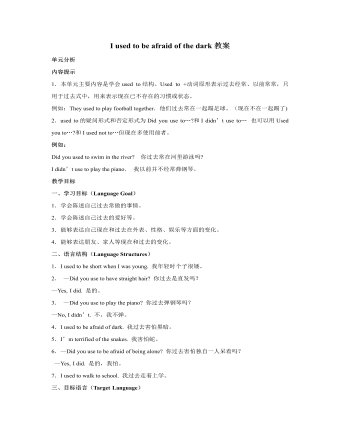
人教版新目标初中英语九年级上册I used to be afraid of the dark教案
内容提示1.本单元主要内容是学会used to结构。Used to +动词原形表示过去经常、以前常常,只用于过去式中,用来表示现在已不存在的习惯或状态。例如:They used to play football together.他们过去常在一起蹋足球。(现在不在一起踢了)2.used to的疑问形式和否定形式为Did you use to…?和I didn’t use to… 也可以用Used you to…?和I used not to…但现在多使用前者。例如:Did you used to swim in the river? 你过去常在河里游泳吗?I didn’t use to play the piano. 我以前并不经常弹钢琴。教学目标一、学习目标(Language Goal) 1.学会陈述自己过去常做的事情。2.学会陈述自己过去的爱好等。3.能够表达自己现在和过去在外表、性格、娱乐等方面的变化。4.能够表达朋友、家人等现在和过去的变化。二、语言结构(Language Structures) 1.I used to be short when I was young. 我年轻时个子很矮。 2. —Did you use to have straight hair? 你过去是直发吗?—Yes, I did. 是的。 3. —Did you use to play the piano? 你过去弹钢琴吗?—No, I didn’t. 不,我不弹。 4.I used to be afraid of dark. 我过去害怕黑暗。 5.I’m terrified of the snakes. 我害怕蛇。
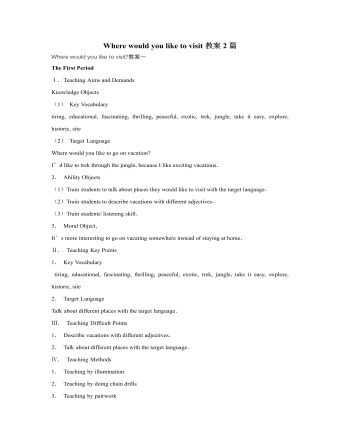
人教版新目标初中英语九年级上册Where would you like to visit教案2篇
The First PeriodⅠ.Teaching Aims and DemandsKnowledge Objects(1) Key Vocabularytiring, educational, fascinating, thrilling, peaceful, exotic, trek, jungle, take it easy, explore, historic, site(2) Target LanguageWhere would you like to go on vacation?I’d like to trek through the jungle, because I like exciting vacations.2. Ability Objects(1)Train students to talk about places they would like to visit with the target language.(2)Train students to describe vacations with different adjectives.(3)Train students' listening skill.3. Moral Object,It′s more interesting to go on vacating somewhere instead of staying at home.Ⅱ. Teaching Key Points1. Key Vocabularytiring, educational, fascinating, thrilling, peaceful, exotic, trek, jungle, take it easy, explore, historic, site2. Target LanguageTalk about different places with the target language.Ⅲ. Teaching Difficult Points1. Describe vacations with different adjectives.2. Talk about different places with the target language.Ⅳ. Teaching Methods1. Teaching by illumination2. Teaching by doing chain drills3. Teaching by pairworkⅤ. Teaching Aids1. A tape recorder2. Some pictures of different places with famous views
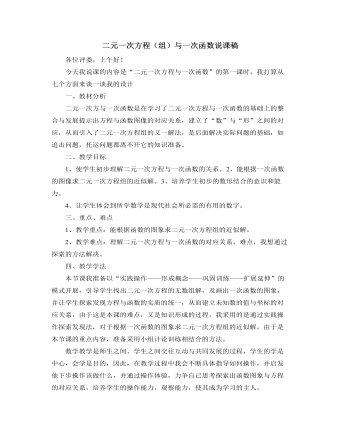
北师大版初中八年级数学上册二元一次方程(组)与一次函数说课稿
在第1环节基础上,再让同学认识到函数Y=2X-1的图象与方程2X-Y=1的对应关系,从而把两个方程组成方程组,让学生在理解二元一次方程与函数对应的基础上认识到方程组的解与交点坐标的对应关系,从而引出二元一次方程组的图象解法。3、例题训练,知识系统化通过书上的例1,用作图象的方法解方程组,让学生明白解题步骤与格式,从而规范理顺所学的图象法解方程组,例题由师生合作完成,由学生说老师写的方式。4、操作演练、形成技能让学生独立完成书P208随堂练习,给定时间,等多数学生完成后,实物投影其完成情况,并作出分析与评价。5、变式训练,延伸扩展通过让学生做收上P208的试一试,而后给一定时间相互交流,并请代表发言他的所悟,然而老师归纳总结,并让学生通过自已尝试与老师的点拔从“数”与“形”两个方面初步体会某些方程组的无解性,进一步发展学生数形结合的意识和能力。6、检测评价,课题作业
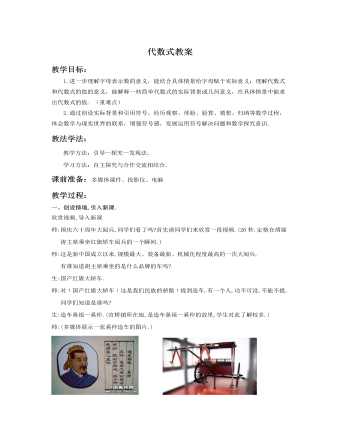
北师大初中七年级数学上册代数式教案2
1.进一步理解字母表示数的意义,能结合具体情景给字母赋于实际意义;理解代数式和代数式的值的意义,能解释一些简单代数式的实际背景或几何意义,在具体情景中能求出代数式的值. (重难点)2.通过创设实际背景和引用符号,经历观察、体验、验算、猜想、归纳等数学过程,体会数学与现实世界的联系,增强符号感,发展运用符号解决问题和数学探究意识. 教法学法:教学方法:引导—探究—发现法.学习方法:自主探究与合作交流相结合.课前准备:多媒体课件、投影仪、电脑教学过程:一、创设情境,引入新课.欣赏视频,导入新课师:国庆六十周年大阅兵,同学们看了吗?首先请同学们来欣赏一段视频.(26秒.定格在胡锦涛主席乘坐红旗轿车阅兵的一个瞬间.)师:这是新中国成立以来,规模最大、装备最新、机械化程度最高的一次大阅兵.
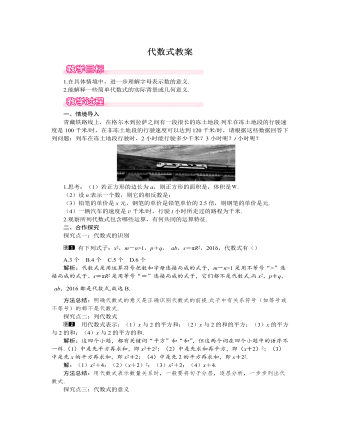
北师大初中七年级数学上册代数式教案1
方法总结:描述一个代数式的意义,可以从字母本身出发来描述字母之间的数量关系,也可以联系生活实际或几何背景赋予其中字母一定的实际意义加以描述.探究点四:根据实际问题列代数式用代数式表示下列各式:(1)王明同学买2本练习册花了n元,那么买m本练习册要花多少元?(2)正方体的棱长为a,那么它的表面积是多少?体积呢?解析:(1)根据买2本练习册花了n元,得出买1本练习册花n2元,再根据买了m本练习册,即可列出算式.(2)根据正方体的棱长为a和表面积公式、体积公式列出式子.解:(1)∵买2本练习册花了n元,∴买1本练习册花n2元,∴买m本练习册要花12mn元;(2)∵正方体的棱长为a,∴它的表面积是6a2;它的体积是a3.方法总结:此题考查了列代数式,用到的知识点包括正方体的表面积公式和体积公式,根据题意列出式子是解本题的关键.
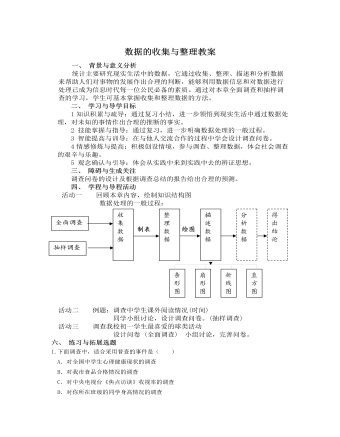
北师大初中七年级数学上册第六章复习教案
一、 背景与意义分析统计主要研究现实生活中的数据,它通过收集、整理、描述和分析数据来帮助人们对事物的发展作出合理的判断,能够利用数据信息和对数据进行处理已成为信息时代每一位公民必备的素质。通过对本章全面调查和抽样调查的学习,学生可基本掌握收集和整理数据的方法。二、 学习与导学目标1 知识积累与疏导:通过复习小结,进一步领悟到现实生活中通过数据处理,对未知的事情作出合理的推断的事实。2 技能掌握与指导:通过复习,进一步明确数据处理的一般过程。3 智能提高与训导:在与他人交流合作的过程中学会设计调查问卷。4 情感修炼与提高:积极创设情境,参与调查、整理数据,体会社会调查的艰辛与乐趣。5 观念确认与引导:体会从实践中来到实践中去的辨证思想。三、 障碍与生成关注调查问卷的设计及根据调查总结的报告给出合理的预测。四、 学程与导程活动活动一 回顾本章内容,绘制知识结构图
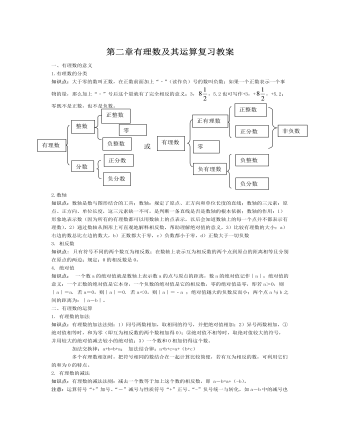
北师大初中七年级数学上册第二章复习教案
. 一个数的倒数等于它本身的数是()A.1 B. C.±1 D.04. 下列判断错误的是()A.任何数的绝对值一定是非负数; B.一个负数的绝对值一定是正数;C.一个正数的绝对值一定是正数; D.一个数不是正数就是负数;5. 有理数a、b、c在数轴上的位置如图所示则下列结论正确的是()A.a>b>0>c B.b>0>a>cC.b<a<0< D.a<b<c<06.两个有理数的和是正数,积是负数,则这两个有理数( )A.都是正数; B.都是负数; C.一正一负,且正数的绝对值较大; D.一正一负,且负数的绝对值较大。7.若│a│=8,│b│=5,且a + b>0,那么a-b的值是( )A.3或13 B.13或-13 C.3或-3 D.-3或-138. 大于-1999而小于2000的所有整数的和是()A.-1999 B.-1998 C.1999 D.20009. 当n为正整数时, 的值是()
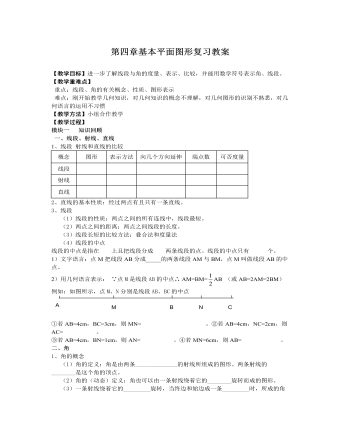
北师大初中七年级数学上册第四章复习教案
1、如图,OA、OB是两条射线,C是OA上一点,D、E是OB上两点,则图中共有 条钱段、它们分别是 ;图中共有 射线,它们分别是 。2、如果线段AB=5cm,BC=3cm,那么A、C两点间的距离是 3、(1)用度、分、秒表示48.26° (2)用度表示37°28′24″ 4、从3点到5点30分,时钟的时针转过了 度。5、一轮船航行到B处测得小岛A的方向为北偏西30°,则从A处观测此B处的方向为( ) A. 南偏东30° B. 东偏北30° C. 南偏东60° D. 东偏北60°6、已知,OA⊥OC,∠AOB∶∠AOC=2∶3,则∠BOC的度数为( )A. 30° B. 150° C. 30°或150° D. 不同于上述答案7、如图,AO⊥OB,直线CD过点O,且∠BOD=130°,求∠AOD的大小。8、已知:如图,B、C两点把线段AD分成2∶4∶3三部分,M是AD的中点,CD=6,求:线段MC的长。9、平面上有n个点(n≥2)且任意三个点不在同一直线上,经过每两个点画一条直线,一共可以画多少条直线?迁移:某足球比赛中有20个球队进行单循环比赛(每两队之间必须比赛一场),那么一共要进行多少场比赛?
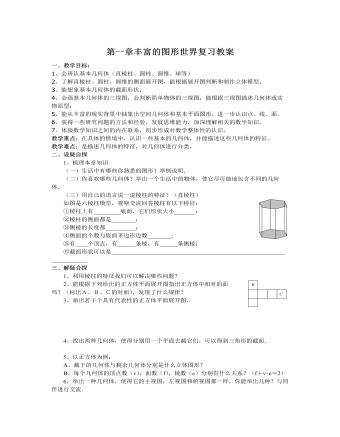
北师大初中七年级数学上册第一章复习教案
一、教学目标:1、会辨认基本几何体(直棱柱、圆柱、圆锥、球等)2、了解直棱柱、圆柱、圆锥的侧面展开图,能根据展开图判断和制作立体模型;3、能想象基本几何体的截面形状;4、会画基本几何体的三视图,会判断简单物体的三视图,能根据三视图描述几何体或实物原型;5、能从丰富的现实背景中抽象出空间几何体和基本平面图形,进一步认识点、线、面。6、获得一些研究问题的方法和经验,发展思维能力,加深理解相关的数学知识。7、体验数学知识之间的内在联系,初步形成对数学整体性的认识。教学重点:在具体的情境中,认识一些基本的几何体,并能描述这些几何体的特征。教学难点:是描述几何体的特征,对几何体进行分类。二、设疑自探1、梳理本章知识(一)生活中有哪些你熟悉的图形?举例说明.(二)你喜欢哪些几何体?举出一个生活中的物体,使它尽可能地包含不同的几何体.(三)用自己的语言说一说棱柱的特征?(直棱柱)
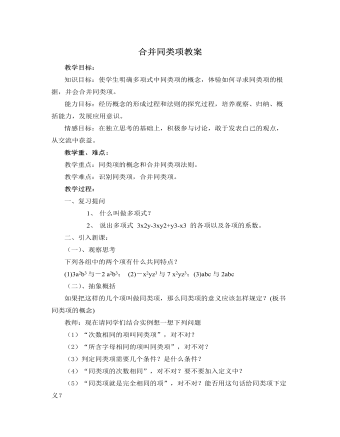
北师大初中七年级数学上册合并同类项教案2
本节课采取了开门见山的切入方法,旨在激发学生的求知欲望,在学生已有的认识基础上,让学生经历了“观察、思考、探究、实践”的过程。在总结出同类项定义后,没有按通常的做法,即直接分析定义中的两个条件,强调两个条件缺一不可,而是通过一组练习,让学生在具体问题中体会定义中的两个条件缺一不可,使他们先有较强烈的感性认识,而后,分析定义中的两个条件,这样会给学生留下更深刻、更牢固的印象.这样的设计既符合学生的年龄特征,也符合“从感性到理性、从具体到抽象”的认知规律。数学不应只强调抽象、严谨,这样不但会更显数学教学的枯燥,而且会使学生在学习中出现畏难情绪,甚至丧失学习数学的兴趣。通过本节课的教学,我认为还存在一些不足,一部分学生的学习能力还有待于进一步培养。如:学习同类项的概念时,当把字母顺序进行改变后,部分学生就认为不是同类项。
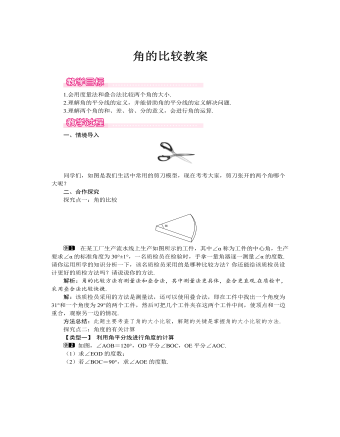
北师大初中七年级数学上册角的比较教案1
1.会用度量法和叠合法比较两个角的大小.2.理解角的平分线的定义,并能借助角的平分线的定义解决问题.3.理解两个角的和、差、倍、分的意义,会进行角的运算.一、情境导入同学们,如图是我们生活中常用的剪刀模型,现在考考大家,剪刀张开的两个角哪个大呢?二、合作探究探究点一:角的比较在某工厂生产流水线上生产如图所示的工件,其中∠α称为工件的中心角,生产要求∠α的标准角度为30°±1°,一名质检员在检验时,手拿一量角器逐一测量∠α的度数.请你运用所学的知识分析一下,该名质检员采用的是哪种比较方法?你还能给该质检员设计更好的质检方法吗?请说说你的方法.解析:角的比较方法有测量法和叠合法,其中测量法更具体,叠合更直观.在质检中,采用叠合法比较快捷.
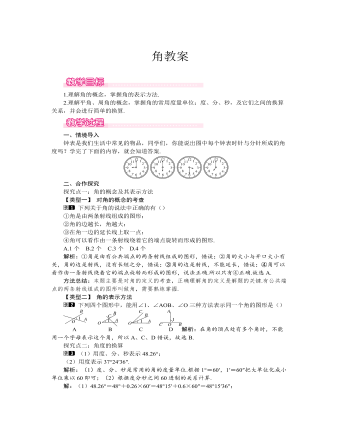
北师大初中七年级数学上册角教案1
1.理解角的概念,掌握角的表示方法.2.理解平角、周角的概念,掌握角的常用度量单位:度、分、秒,及它们之间的换算关系,并会进行简单的换算.一、情境导入钟表是我们生活中常见的物品,同学们,你能说出图中每个钟表时针与分针所成的角度吗?学完了下面的内容,就会知道答案.二、合作探究探究点一:角的概念及其表示方法【类型一】 对角的概念的考查下列关于角的说法中正确的有()①角是由两条射线组成的图形;②角的边越长,角越大;③在角一边的延长线上取一点;④角可以看作由一条射线绕着它的端点旋转而形成的图形.A.1个 B.2个 C.3个 D.4个解析:①角是由有公共端点的两条射线组成的图形,错误;②角的大小与开口大小有关,角的边是射线,没有长短之分,错误;③角的边是射线,不能延长,错误;④角可以看作由一条射线绕着它的端点旋转而形成的图形,说法正确.所以只有④正确.故选A.
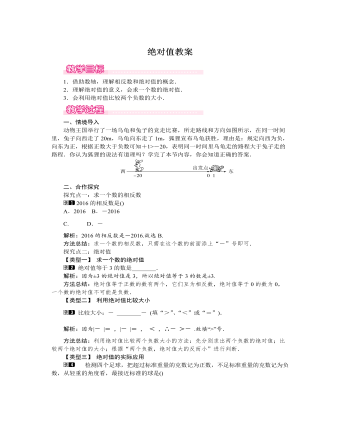
北师大初中七年级数学上册绝对值教案1
方法总结:由绝对值的定义可知,一个数的绝对值越小,离原点越近.将实际问题转化为数学问题,即为与标准质量的差的绝对值越小,越接近标准质量.【类型四】 绝对值的非负性已知|x-3|+|y-2|=0,求x+y的值.解析:一个数的绝对值总是大于或等于0,即为非负数,若两个非负数的和为0,则这两个数同为0.解:由题意得x-3=0,y-2=0,所以x=3,y=2.所以x+y=3+2=5.方法总结:几个非负数的和为0,则这几个数都为0.三、板书设计绝对值相反数绝对值性质→|a|=a(a>0)0(a=0)-a(a<0)互为相反数的两个数的绝对值相等两个负数比较大小:绝对值大的反而小绝对值这个名词既陌生,又是一个不易理解的数学术语,是本章的重点内容,同时也是一个难点内容.教材从几何的角度给出绝对值的概念,也就是从数轴上表示数的点的位置出发,得出定义的.
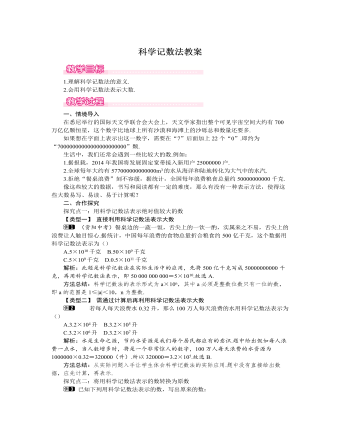
北师大初中七年级数学上册科学记数法教案1
解析:水是生命之源,节约水资源是我们每个居民都应有的意识.题中给出假如每人浪费一点水,当人数增多时,将是一个非常惊人的数字,100万人每天浪费的水资源为1000000×0.32=320000(升).所以320000=3.2×105.故选B.方法总结:从实际问题入手让学生体会科学记数法的实际应用.题中没有直接给出数据,应先计算,再表示.探究点二:将用科学记数法表示的数转换为原数已知下列用科学记数法表示的数,写出原来的数:(1)2.01×104;(2)6.070×105.解析:(1)将2.01的小数点向右移动4位即可;(2)将6.070的小数点向右移动5位即可.解:(1)2.01×104=20100;(2)6.070×105=607000.方法总结:将科学记数法a×10n表示的数,“还原”成通常表示的数,就是把a的小数点向右移动n位所得到的数.三、板书设计借助身边熟悉的事物进一步体会大数,积累数学活动经验,发展数感、空间感,培养学生自主学习的能力.